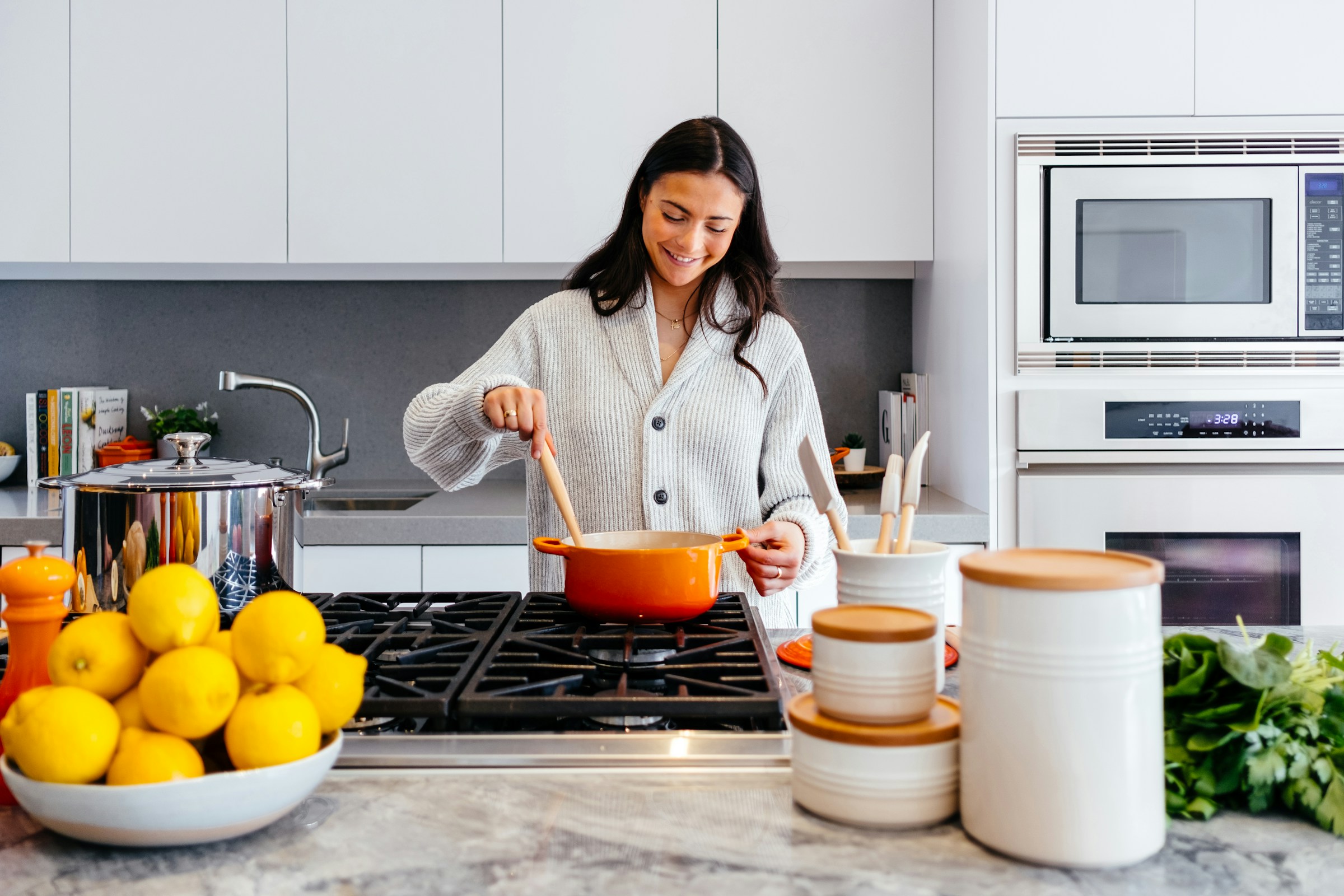Transform Your UK Kitchen: A Guide to Seamlessly Integrating Smart Home Technology
In the heart of every home, the kitchen is more than just a place to cook; it’s a hub of activity, creativity, and connection. With the advent of smart home technology, transforming your UK kitchen into a sleek, efficient, and highly functional space has never been more achievable. Here’s a comprehensive guide to help you integrate smart home technology into your kitchen, enhancing your cooking experience, energy efficiency, and overall lifestyle.
The Future of Kitchen Appliances: Smart and Integrated
The future of kitchen appliances is all about integration, automation, and smart technology. These advancements are not just about adding gadgets; they are about creating a cohesive and efficient cooking environment.
In parallel : Essential Tips for Caring for Your Granite Countertop in a UK Kitchen
Automation and Personalization
Automation is a key driver in this transformation. Future kitchens are not only automated but also trainable, meaning that appliances can learn your preferences and habits over time. For instance, a smart refrigerator like the LG InstaView ThinQ can track your inventory and suggest recipes based on the ingredients you have on hand. This level of personalization makes daily routines more efficient and enhances the overall cooking experience.
Energy Efficiency
Next-generation kitchen appliances are engineered to reduce energy consumption, contributing to a more sustainable lifestyle. Devices like smart refrigerators and energy-efficient dishwashers are becoming common fixtures in modern kitchens. The Ecobee SmartThermostat, for example, can learn your temperature preferences and adjust the heating and cooling system accordingly, optimizing energy use and reducing your utility bills.
Also to discover : Budget-Friendly Tips for Designing a Chic Minimalist Kitchen in the UK
Space-Saving Solutions
As urbanization continues to rise, space-saving solutions are becoming increasingly important. Multi-tasking appliances such as steam ovens, compact air fryers, and flexible dishwasher drawers are designed to maximize utility without compromising on performance. These modular appliances enhance both efficiency and storage, making small kitchens feel larger and more organized.
Smart Integration: The Power of IoT
The utilization of Internet of Things (IoT) technology in integrated appliances is a game-changer. Smart kitchen technology enables streamlined routines and offers control at your fingertips.
Connectivity and Control
Imagine a kitchen where your coffee maker starts brewing your morning cup as soon as your alarm goes off, or a smart tap that dispenses water at the perfect temperature for your evening tea. IoT facilitates connectivity among appliances, allowing them to communicate with each other and with you. You can preheat your oven remotely through your smartphone, control settings using voice commands via AI assistants like Siri, Google Home, or Alexa, or get notified when your refrigerator is running low on essentials.
Real-Life Applications
Consider a smart refrigerator equipped with internal cameras. You can check its contents remotely via an app, ensuring you never forget an item while grocery shopping. Intelligent freshness monitors can alert you when food is about to spoil, reducing waste and saving money. Smart ovens can be preheated on your way home through a simple voice command or smartphone app, and some models offer recipe guides that adjust cooking times and temperatures according to the dish you plan to make.
Enhancing Your Kitchen Experience with Smart Devices
Here are some smart devices that can significantly enhance your kitchen experience:
Smart Refrigerators
- LG InstaView ThinQ: Features a window that lights up with two quick knocks, revealing its contents without losing cold air. It also tracks inventory and suggests recipes based on available ingredients.
Smart Ovens
- June Smart Oven: Combines the capabilities of several appliances into one and uses AI to suggest healthier recipes, monitor food as it cooks, and ensure that meals are prepared perfectly every time.
Smart Dishwashers
- Miele Dishwasher: Optimizes water and energy use, and can be controlled remotely through a smartphone app. It also features sensor-driven safety features to enhance safety and efficiency.
Practical Insights and Actionable Advice
Choosing the Right Smart Home Platform
When integrating smart home technology into your kitchen, choosing the right platform is crucial. You have three main choices: Amazon Alexa, Google Home, and Apple HomeKit. Ensure that the devices you choose are compatible with your preferred voice assistant to create seamless routines and control your gadgets hands-free.
Ensuring Energy Efficiency
Smart home devices like the Ecobee SmartThermostat and Lutron Caseta Wireless Smart Lighting offer energy-efficient solutions that minimize environmental impact without compromising on comfort. These devices can help you monitor and control your home’s heating, cooling, and lighting systems, optimizing energy use and reducing your utility bills.
Enhancing Security and Privacy
In addition to kitchen appliances, smart home technology can also enhance security and privacy. Advanced security systems like the ADT Command & Control Smart Security and Vivint Smart Home Security System offer features such as AI-powered facial recognition and real-time alerts. Smart locks like the Kwikset Halo Touch and Schlage Encode Smart WiFi Deadbolt provide enhanced security with biometric access and remote lock/unlock capabilities.
Design Considerations for a Smart Kitchen
Open-Concept Living Spaces
Open-concept layouts are incredibly popular in modern homes, including luxury residences. This layout creates a sense of spaciousness, allowing for an uninterrupted flow between the living room, dining area, and kitchen. It enhances the aesthetic appeal and facilitates better interaction, making it ideal for entertaining guests or spending time with family.
Premium Finishes and Materials
High-quality finishes are a defining characteristic of a smart kitchen. Consider using premium materials such as marble, granite, hardwood, and custom millwork throughout your kitchen. These finishes provide a sense of elegance and durability, which are essential elements in a modern kitchen.
Real-World Examples and Case Studies
Luxury Homes with Smart Kitchens
Luxury homes often serve as benchmarks for smart kitchen design. For instance, the Antilia Mansion in Mumbai, India, features state-of-the-art smart home technology, including automated lighting, climate control, and advanced security systems. Similarly, Villa Leopolda in France is equipped with smart appliances and home automation systems that enhance the living experience.
Smart Home Integration in Everyday Homes
Even in everyday homes, smart kitchen technology can make a significant difference. For example, a family in the UK integrated smart devices into their kitchen, including a smart refrigerator, oven, and dishwasher. They reported a significant reduction in energy consumption and an improvement in their overall cooking experience.
Table: Comparing Popular Smart Kitchen Appliances
| Appliance | Features | Compatibility | Energy Efficiency |
|---|---|---|---|
| LG InstaView ThinQ Refrigerator | Internal cameras, inventory tracking, recipe suggestions | Amazon Alexa, Google Home, Apple HomeKit | High energy efficiency with advanced cooling system |
| June Smart Oven | Multi-functional, AI-driven recipe suggestions, real-time cooking monitoring | Amazon Alexa, Google Home | Energy-efficient cooking modes |
| Miele Dishwasher | Remote control, sensor-driven safety features, optimized water and energy use | Amazon Alexa, Google Home | High energy efficiency with EcoMode |
| Ecobee SmartThermostat | Learning thermostat, remote control, energy-saving features | Amazon Alexa, Google Home, Apple HomeKit | High energy efficiency with smart heating and cooling |
| Lutron Caseta Wireless Smart Lighting | Dimmable lighting, remote control, energy-saving features | Amazon Alexa, Google Home, Apple HomeKit | High energy efficiency with smart lighting control |
Transforming your UK kitchen with smart home technology is not just about adding gadgets; it’s about creating a seamless, efficient, and personalized cooking environment. By integrating smart appliances, leveraging IoT technology, and considering design and energy efficiency, you can turn your kitchen into a hub of innovation and comfort.
Final Tips
- Start Small: Begin with one or two smart devices and gradually expand your smart kitchen ecosystem.
- Choose Compatible Devices: Ensure all your smart devices are compatible with your preferred voice assistant.
- Monitor Energy Use: Regularly check your energy consumption to optimize your smart home settings.
- Enhance Security: Integrate smart security features to protect your home and personal data.
By following these guidelines and embracing the latest smart home technologies, you can create a kitchen that is not only smart but also efficient, secure, and perfectly tailored to your daily needs.
List: Key Benefits of Smart Kitchen Technology
- Enhanced Efficiency: Smart appliances and automation streamline your cooking routines.
- Energy Efficiency: Smart devices optimize energy consumption, reducing your utility bills.
- Personalization: Appliances learn your preferences and habits, offering personalized cooking experiences.
- Space-Saving Solutions: Multi-tasking appliances maximize utility without compromising on space.
- Improved Security: Advanced security systems and smart locks enhance home security.
- Convenience: Control your kitchen devices remotely through voice commands or smartphone apps.
- Sustainability: Smart home devices promote a more sustainable lifestyle by minimizing environmental impact.
- Design Flexibility: Smart technology integrates seamlessly with various kitchen designs, including open-concept layouts and premium finishes.
By embracing these benefits, you can transform your kitchen into a smart, efficient, and luxurious space that enhances your daily life.






